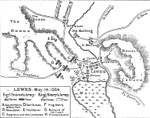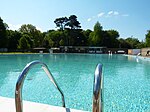Offham Marshes
Sites of Special Scientific Interest in East Sussex

Offham Marshes, also known as The Pells and Offham Marsh, is a 39.1-hectare (97-acre) biological Site of Special Scientific Interest on the northern outskirts of Lewes in East Sussex in parish of Hamsey. It includes the Pellbrook Cut, an area to the north of it called The Pells and the marshland to the south of the Cut and east of the railway track.
Excerpt from the Wikipedia article Offham Marshes (License: CC BY-SA 3.0, Authors, Images).Offham Marshes
Landport Farm Road,
Geographical coordinates (GPS) Address Nearby Places Show on map
Geographical coordinates (GPS)
| Latitude | Longitude |
|---|---|
| N 50.888 ° | E -0.005 ° |
Address
Landport Farm Road
Landport Farm Road
BN7 2FP
England, United Kingdom
Open on Google Maps










